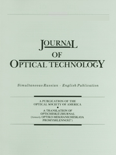
OPTICAL ENGINEERING
Scope & Guideline
Driving excellence in photonics and engineering.
Introduction
Aims and Scopes
- Advancements in Optical Materials and Devices:
Research focusing on new materials, coatings, and device architectures that enhance optical performance, including lasers, lenses, and fiber optics. - Imaging Systems and Techniques:
Studies related to the design, calibration, and application of imaging systems, including digital holography, interferometry, and optical coherence tomography. - Optical Communication Technologies:
Development and optimization of optical communication systems, including free-space optical communication, fiber-optic networks, and visible light communication. - Sensors and Measurement Techniques:
Innovations in optical sensing technologies for environmental monitoring, biomedical applications, and industrial processes, utilizing various optical techniques. - Computational Methods in Optics:
Application of computational techniques such as machine learning and numerical simulations to solve complex optical problems and enhance design processes. - Optical Engineering Education and Training:
Research and methodologies aimed at improving optics education, including curriculum development and the use of advanced teaching tools.
Trending and Emerging
- Integration of Machine Learning and AI in Optics:
A growing trend is the incorporation of artificial intelligence and machine learning techniques in optical systems, enhancing capabilities in imaging, sensing, and data analysis. - Advancements in Fiber Optic Technologies:
Research on new fiber optic designs, including photonic crystal fibers and advanced sensors, is gaining momentum, driven by the demand for high-speed communication and sensing applications. - Development of Terahertz Technologies:
The exploration of terahertz waves for imaging and communication applications is increasingly prominent, reflecting a burgeoning interest in this underutilized part of the electromagnetic spectrum. - Optical Imaging in Biomedical Applications:
There is a significant increase in research focused on optical imaging techniques for biomedical applications, including diagnostics and therapy, driven by innovations in imaging technologies. - Sustainable and Green Photonics:
Emerging research trends are focusing on environmentally friendly optical materials and processes, highlighting the importance of sustainability in optical engineering.
Declining or Waning
- Traditional Optical Design Methods:
There has been a noticeable shift towards computational and machine learning approaches for optical design, resulting in traditional methods becoming less frequently discussed. - Basic Optical Phenomena:
Research focused on foundational optical phenomena, such as simple lens behavior and basic diffraction patterns, appears to be waning as more complex applications and technologies gain prominence. - Static Imaging Techniques:
With the rise of dynamic imaging and real-time processing methods, static imaging techniques are being explored less frequently, as the field moves towards applications requiring higher temporal resolution.
Similar Journals

eLight
Pioneering Discoveries in the Dynamic World of PhysicseLight is a leading academic journal published by SPRINGER NATURE, dedicated to the dynamic field of Atomic and Molecular Physics, as well as Electronic, Optical, and Magnetic Materials. Launched in 2021, the journal has quickly established itself as a reputable source of cutting-edge research, evidenced by its impressive Q1 quartile rankings in both categories for 2023, alongside remarkable Scopus rankings that place it in the top 2% of its fields. With a commitment to advancing knowledge and fostering innovation, eLight invites contributions from researchers, professionals, and students who are passionate about exploring new frontiers in these critical areas of study. Hitting a critical intersection of physics and materials science, the journal provides an open forum for the dissemination of experimental findings, theoretical studies, and application-based research, ensuring accessibility to vital discoveries that drive progress in technology and academia. Located in Singapore, eLight is poised to make significant contributions to the scientific community until at least 2024, and beyond.

JOURNAL OF BIOMEDICAL OPTICS
Illuminating the Future of Biomedical ResearchJOURNAL OF BIOMEDICAL OPTICS, published by SPIE-SOC PHOTO-OPTICAL INSTRUMENTATION ENGINEERS, is a premier Open Access journal that has been at the forefront of research in the fields of optical engineering and biomedical applications since its inception in 1996. With an impressive range of studies that span atomic and molecular physics, biomedical engineering, and biomaterials, this journal is consistently recognized for its high-quality publications, evidenced by its Q1 quartile ranking in 2023 for Atomic and Molecular Physics and Optics. The journal’s impact is further validated by its Scopus rankings, placing it in the top 30% of its categories. Designed to facilitate rapid dissemination of innovative advancements in biomedical optics, this journal promotes an interdisciplinary approach, making it an essential resource for researchers, professionals, and students aiming to advance their knowledge and applications of optical technologies in medicine. The journal is committed to broadening access to groundbreaking research, having transitioned to Open Access in 2019, ensuring that the latest findings are available to a global audience.

Journal of Optics-India
Illuminating Innovations in Atomic and Molecular PhysicsThe Journal of Optics-India, published by SPRINGER INDIA, serves as a vital platform dedicated to advancing research in the field of optics, focusing on topics in both atomic and molecular physics. With an ISSN of 0972-8821 and an E-ISSN of 0974-6900, the journal has been a consistent contributor to the field since its inception in 1996 and continues to thrive with its anticipated convergence through 2024. Although currently classified in Q3 of the 2023 category quartiles, the journal actively seeks to elevate its standing within Scopus rankings in physics and astronomy, where it holds a rank of 143/224, indicating significant opportunities for growth and research impact. The Journal of Optics-India is committed to fostering innovative research and providing scholars and practitioners with access to cutting-edge findings, thereby enhancing global conversations around optics and its vast applications. As a reliable source for researchers, professionals, and students alike, the journal emphasizes quality contributions that shape the future of optical science.

OPTICAL FIBER TECHNOLOGY
Exploring Breakthroughs in Optical Fiber TechnologyOPTICAL FIBER TECHNOLOGY is a premier journal in the fields of atomic and molecular physics, optics, control and systems engineering, as well as electrical and electronic engineering, published by ELSEVIER SCIENCE INC. With an ISSN of 1068-5200 and E-ISSN 1095-9912, it offers a platform for disseminating cutting-edge research and developments in optical fiber technology and its applications. The journal has achieved a notable impact, ranking in the second quartile for multiple categories in 2023, including control and systems engineering and electronic, optical, and magnetic materials. By providing a robust avenue for peer-reviewed articles, OPTICAL FIBER TECHNOLOGY caters to a diverse audience of researchers, professionals, and students dedicated to advancing knowledge and innovation in optics and related fields. This respected journal is particularly suited for those seeking to stay updated on the latest technological advancements and research trends, ensuring its relevance in both academic and industrial contexts.

Korean Journal of Optics and Photonics
Shaping Tomorrow's Technologies with LightKorean Journal of Optics and Photonics is a premier publication dedicated to advancing knowledge in the rapidly evolving fields of optics and photonics. Published by the esteemed Optical Society of Korea, this journal serves as a vital platform for researchers, professionals, and students seeking to disseminate their findings and innovations in areas such as optical engineering, photonics technologies, and application developments. Although the journal does not operate under an Open Access model, it is committed to high-quality peer-reviewed research that contributes significantly to both theoretical and practical advancements in the field. With an increasing focus on interdisciplinary research, the Korean Journal of Optics and Photonics is poised to play a crucial role in fostering collaboration and driving the global conversation on light science and technology. The journal's ISSN is 1225-6285 and it also carries the E-ISSN 2287-321X, ensuring its availability to a wide readership.

FIBER AND INTEGRATED OPTICS
Connecting Ideas in Integrated Optics and BeyondFIBER AND INTEGRATED OPTICS is a prominent academic journal published by TAYLOR & FRANCIS INC, focusing on the cutting-edge domains of optical and fiber technologies. Since its inception in 1977, the journal has journeyed through expansive developments in the fields of Atomic and Molecular Physics, as well as Electronic, Optical, and Magnetic Materials, boasting a converged publication history extending to 2024. With a solid reputation reflected in its Q3 rankings in both aforementioned categories, FIBER AND INTEGRATED OPTICS serves as an essential platform for researchers, professionals, and students to disseminate and explore innovative findings and methodologies. Although currently not offering Open Access, its scholarly contributions remain invaluable, fostering a deeper understanding and advancements in fiber optic applications and integrated optical systems. Situated in the United Kingdom, the journal continues to attract a diverse global audience, solidifying its significance in contemporary scientific discourse.

Advanced Photonics
Transforming Research into Real-World SolutionsAdvanced Photonics, published by SPIE-SOC PHOTO-OPTICAL INSTRUMENTATION ENGINEERS, is a prestigious open-access journal dedicated to cutting-edge research in the fields of photonics, optics, biomedical engineering, and material science. Since its inception in 2019, this journal has successfully established itself in the top quartile (Q1) of various categories, including Atomic and Molecular Physics, Biomedical Engineering, and Electronic, Optical and Magnetic Materials, showcasing its critical role in advancing knowledge and innovation within these disciplines. With impressive Scopus rankings—#8 in Biomedical Engineering, #7 in Atomic and Molecular Physics, and #10 in Materials Science—Advanced Photonics serves as an essential platform for researchers, professionals, and students alike, offering a wealth of accessible scholarly content to keep pace with rapid technological developments. The journal not only fosters collaboration and knowledge dissemination within the global scientific community but also emphasizes the importance of open access to ensure that groundbreaking research benefits society as a whole.

OPTICS EXPRESS
Shaping Tomorrow’s Optical Landscape TodayOPTICS EXPRESS is a premier peer-reviewed journal published by the Optica Publishing Group, specializing in the rapidly evolving fields of Atomic and Molecular Physics and Optics. With an impressive Q1 ranking in its category and positioned in the 75th percentile among leading journals in Physics and Astronomy, OPTICS EXPRESS serves as a vital platform for disseminating innovative research findings. Since its inception in 1997 and transitioning to Open Access in 1998, the journal has ensured that groundbreaking scientific contributions are accessible to a global audience, fostering collaboration and advancement in optical science. Additionally, with annual publications converging from 1997 to 2024, this journal not only tracks the latest advancements but also shapes the future landscape of optics research. Whether you are a seasoned researcher, a dedicated professional, or a passionate student, OPTICS EXPRESS offers a wealth of knowledge and a commitment to excellence in the optics community.

JOURNAL OF MODERN OPTICS
Empowering Researchers in the Realm of LightJOURNAL OF MODERN OPTICS, published by Taylor & Francis Ltd, stands as a prominent bi-monthly journal contributing to the fields of Atomic and Molecular Physics and Optics. With an ISSN of 0950-0340 and an E-ISSN of 1362-3044, this journal aims to disseminate high-quality research that pushes the boundaries of optical science and its applications. Since its inception in 1981, and particularly throughout its publications from 1987 to 2024, the journal has consistently published influential studies that are essential for both academic researchers and industry professionals. Ranked in the Q3 quartile for the 2023 category of Atomic and Molecular Physics and Optics, it has a Scopus ranking of #133 out of 224, indicating its steady presence and relevance in the scientific community. Although it does not offer Open Access options, readers can access its rich repository of literature that delves into innovative optical methods, technological advancements, and theoretical frameworks. The JOURNAL OF MODERN OPTICS is an indispensable resource for those seeking to advance their knowledge and research in modern optical science.

JOURNAL OF OPTICAL TECHNOLOGY
Exploring the Depths of Light and EngineeringJOURNAL OF OPTICAL TECHNOLOGY, published by the Optica Publishing Group, serves as a vital resource for researchers and professionals in the fields of optical technology and related disciplines. Established with a commitment to advancing knowledge, this journal spans a broad spectrum of topics, including applied mathematics, atomic and molecular physics, and various engineering disciplines, with a converged publication period from 1995 to 2024. Although it currently holds a Q4 ranking across multiple categories in 2023, it is an important platform for innovative research ideas in a rapidly evolving field. The absence of Open Access may guide readers to explore alternative access options through institutional subscriptions. The journal’s ISSN is 1070-9762 and its E-ISSN is 1091-0786, ensuring accessibility for a global audience. As a publication aimed at fostering scholarly communication, it invites contributions that highlight emerging trends and novel developments in optical technology, catering to a multifaceted audience of researchers, professionals, and students.